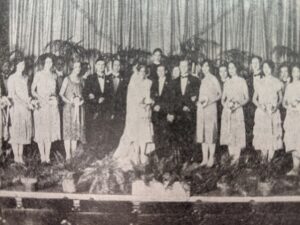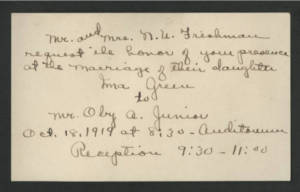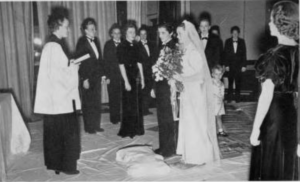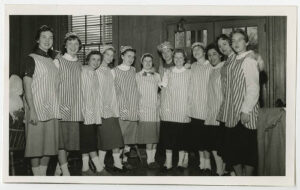One of the many lost campus traditions is that of the mock wedding between the Freshman and Junior classes. This ritual was often seen in girls’ colleges during the early 20th century and involved the symbolic union between the two classes for the years that they were at school. At the North Carolina College for Women (now UNC Greensboro), these all-girl ceremonies were held in the fall and were intended to ease the Freshmen into their college life by joining them with more experienced students who could help them navigate the new environment. The “sister classes” would be linked for two years, until the Juniors graduated – then the Freshmen would move into the mentor position for the incoming class.
Traditionally, the Juniors made the arrangements for the elaborate event, including the wedding music, decorations, and vows. In the early years, hand-written invitations were sent, but eventually more formal invitations announced the nuptials. The comic nature of the event was reflected by the humorous names used by the bride and groom, such as in 1919 when “Miss Ima Green” married “Mr. Oby A. Junior,” or in 1925, when the couple were named “Miss Evva Blue Freshman” and “Mr. B. A. Happy Junior.” Some years, only students from the Freshman and Junior classes and several others honorary guests were invited, but eventually it included the entire student body. Occasionally, such as 1939, the identity of the bride and groom was kept a secret until the ceremony.
The Freshmen members of the “wedding party” would dress as maids of honor, flower girls, and trainbearers, while the Juniors served as groomsmen, ushers, and readers. Faculty took the role of the parents of the bride and groom, and appropriately, and comically, sobbed into their handkerchiefs. Although it was definitely a tongue in cheek ritual, the participants took it very seriously. The ceremony was held in the auditorium of the Students’ Building, and the large stage was decorated like a church, with English ivy, green ferns, palms, white flowers, and candelabras. White bunting and festive trimming created a celebratory atmosphere in the auditorium. The wedding party was dressed for the occasion with the bridesmaids attired in yellow, green, blue, and lavender dresses, and the bride wearing an elegant white dress and a corsage. Those who attended the events marveled at how “realistic” the groom and groomsmen appeared dressed in black tuxedos with their hair slicked back. Before the ceremony, the attendees were serenaded by the school’s pipe organ and bridal songs, such as “I Love You” and “Because,” as well as the school song. The Freshman “bride” was walked down the aisle by her “father” to the traditional “Wedding March” and a ring ceremony was performed by a student “preacher.”
In 1925, the ceremony was as follows:
“Guided hither, O happy pair, enter this portal ‘tis love that invites – Flower of beauty and youth and manhood. You have come to this sacred altar of the school tradition to form another link, strong and lasting, which will be added to that silvery chain that has been forming since the day when the world was young. It is your responsibility to keep your link pure and spotless. If it is tarnished woe be unto you. You have come to the altar of the institution of tradition, I say, to add your link to the chain. It must be one and inseparable. If there is any reason why the link should not be formed let mortal man speak now or forever hold his peace.”
“Evva Blue Freshman, are you willing, under the laws prescribed by tradition, to tie the knot, becoming one and inseparable, and add your link to the chain, until the day when mortal joins immortal? This ring is the outward ceremony of the promise you have made. Look at it; think of it. As often as you wear it you will do it in remembrance of the link added to the silvery chain, and it has been recorded by the slowly moving hand of the god of tradition. It will last throughout the ages. Blest be the tie that binds fellow man with fellow man; friend with friend; companion with companion; and service with service. Peace, peace, peace. My peace I give unto you. Amen.”
After the “service,” the wedding party would adjourn to one of the Literary Societies’ large reception halls and join the receiving line. Then all the students danced and enjoyed refreshments, including ice cream and punch. Just like a real wedding, photographs were taken of the bridal party and a detailed description of the festive event was published in the school newspaper, including the names of the bridesmaid and groomsmen, and their hometowns. In fact, some years saw a separate student position dedicated totally to wedding publicity.
This tradition continued into the 1940s when the wedding ceremony was replaced by “Sister Day.” This event was sometimes held over two days, during which both classes honored each other, and were officially joined as sister classes. These festive occasions included dressing in matching outfits, fun themed events and competitions, and a celebratory dinner. In 1958, the Freshmen even wrote the Juniors a poem and served them at dinner.
By 1963, the year that the school became a co-ed university, Sister Day was no longer the elaborate occasion it had once been, with the celebration mainly involving a special dinner in the cafeteria. Finally, it became one of the many school traditions that fell by the wayside to create a more welcoming environment for the male students. By the mid-1960s, the event no longer appears in campus records.
By Kathelene McCarty Smith



